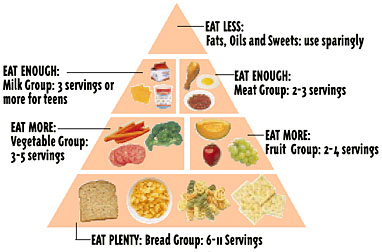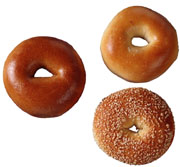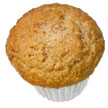
There are six food groups in
the pyramid: breads/ cereal/ rice/ pasta; vegetables; fruits; milk/ yogurt/ cheese;
meat/ poultry/ fish/ eggs/ beans/ nuts; and fats/ oils/ sweets. Five groups are
needed daily.
|
|
Click here for the printable (Word) version of the lesson
The Food Guide Pyramid
Introduction
The Food Guide Pyramid is a tool designed to promote the concepts of variety,
moderation and balance in the diet. Variety means eating foods from all food groups,
moderation means limiting the amount of high sugaror high fat foods, and balance means
eating the number of servings recommended according to your individual calorie
needs. The Food Guide Pyramid is based on the Dietary Guidelines for Americans and
is also designed to provide the recommended dietary allowances for calories, fiber and
nutrients.

There are six food groups in the pyramid: breads, cereal, rice, pasta;
vegetables; fruits; milk, yogurt, cheese; meat, poultry, fish, eggs, beans and nuts; and
fats, oils and sweets. Five major groups are needed daily. We just need a
little bit of the last group to round out our meals. Foods in the sixth group should
be eaten sparingly. No one food group is more important than another. There
are no "good" foods or "bad" foods. However, it is important to
balance the high fat or high sugar foods with low fat or low sugar foods over a period of
one or two days. Foods that have three or less grams of fat per 100 calories are
considered low in fat.
What You Will Learn
and How it Will be Useful to You
After completing this lesson, you will be able to:
Name the five major food groups pictured in the Food Guide Pyramid.
Describe the symbols for fat and sugar and name the foods that are sources of these
nutrients (including food groups in the rest of the pyramid).
List the range of servings recommended for each food group.
Understand serving sizes.
Understand that fat intake should be limited to 30% of calories.
Give suggestions for food selection and preparation methods to help moderate sugar and
fat intake.
Understand that exercise is an important part of a healthy lifestyle.
Visit the Healthy Choice web site to learn some nutrition
facts.
Group One:
Breads, Cereals, Rice and Pasta
 Bread, cereal, rice
and pasta are the foundation of a well-balanced diet. Foods in this group
provide key nutrients for a variety of uses: Bread, cereal, rice
and pasta are the foundation of a well-balanced diet. Foods in this group
provide key nutrients for a variety of uses:
- B-vitamins - help use energy from food, keep the skin healthy and help digestion and
appetite
- Iron - builds red blood cells
- Protein - for growth and repair of body tissues
- Carbohydrate - for energy
- Fiber - prevents constipation
Some foods in this group include biscuits, bread, ready-to-eat cereals, cooked cereals
(oatmeal, grits and cream of wheat), cornmeal, macaroni, muffins, noodles, pancakes, rice,
spaghetti, tortillas, waffles, graham crackers, saltine crackers and popcorn.
The Food Guide Pyramid recommends six to eleven
servings from the bread, rice, cereal and pasta group daily. Serving sizes for this
group are:
Bread - One slice
Biscuit, roll or muffin - One small
Tortilla - One
Waffle or pancake - One
Crackers - Five small or two large
Hamburger or hot dog bun - One-half
Ready-to-eat cereal - One ounce
Cooked cereal, grits, rice, macaroni, spaghetti and noodles - One-half cup
Some of the best buys in the bread, cereal, rice and pasta group are:
|
|
| Enriched white rice, brown
rice Enriched macaroni, noodles and spaghetti
Enriched white or whole-grain bread
Saltine crackers
Cornbread or muffins made from scratch
Cornbread, muffin or biscuit mix
Enriched flour |
Instant rice, seasoned rice,
wild rice Pasta in special shapes (curls, shells)
Specialty breads
Specialty crackers
Mixes
Ready-to-eat muffins, biscuits
Cake flour |
Other cost-saving tips for the bread, cereal, rice and pasta group include:
 Buy ready-to-eat
cereals in large boxes or bags instead of single serving boxes. Buy ready-to-eat
cereals in large boxes or bags instead of single serving boxes.
Buy day-old bread and shop at bread outlets.
Use stale bread for toast, casseroles, French toast, grilled sandwiches, bread pudding
and stuffing.
Compare bread prices by weight, not by size of the package. A large loaf of bread may
contain a lot of air.
Buy store brands or generic bread products. These are usually cheaper than name
brands.
Make your own baking mixes for cornbread, biscuits and muffins. These are
usually cheaper than ready-made mixes.
Use foods in the bread, cereal, rice and pasta group in casseroles to stretch your food
dollar.
Make sure to read the labels on these products, so you will know what you are
buying. Some terms you may find on the labels include:
Whole-grain: These are made from whole kernels of grain. These are a
good source of fiber. It is recommended that we eat at least three servings of
whole-grain foods each day, such as whole-grain breads and cereals, brown rice and
whole-grain pastas.
Enriched: Vitamins and iron are lost when grain is milled to make white
flour or meal. Enriched flour or meal has vitamins and iron added during
processing. However, fiber lost during milling is not added back.
Fortified: Many breakfast cereals have extra vitamins and minerals
added. These are called fortified products. They are usually more expensive
than those which have not been fortified.
Storage tips for the bread, cereal, rice and pasta group:
 Bread stored at room
temperature stays fresh longest. Bread stored in the refrigerator gets stale faster
but will not mold quickly. You may freeze bread for up to six months. Store
rice, flour, noodles and cornmeal, etc. in tightly closed containers in a dry place. Bread stored at room
temperature stays fresh longest. Bread stored in the refrigerator gets stale faster
but will not mold quickly. You may freeze bread for up to six months. Store
rice, flour, noodles and cornmeal, etc. in tightly closed containers in a dry place. - Washing rice and rinsing cooked spaghetti and noodles removes important vitamins.
Flash Card Quiz:
1. Which food has the least calories?
- One-half cup cottage cheese
- Two ounces of lean beef
- One slice bread
|
| Answer: Bread - One slice contains
only 80 calories. Both the two ounces of beef and the one-half cup of cottage cheese
have 120 calories. |
2. Which food has the least calories?
- Whole hamburger bun
- Three ounce hamburger patty
- Small bag potato chips
|
| Answer: Hamburger bun - this has 160
calories. The hamburger patty has 185 calories, and the chips have 175 calories. |
3. Which food has the least calories?
- One baked chicken leg
- One-half cup rice
- One 12 ounce can of cold drink
|
| Answer: Rice - One-half cup of rice has
only 80 calories. The chicken leg contains 140 calories, and a 12 ounce can cold
drink contains 150 calories. |
Is bread fattening?
Many people think bread products are fattening. This is not true, though.
It is not the bread that is fattening; it's what we put on the bread. If you
add a pat of butter and a tablespoon of grape jelly to the bread, it will have 160
calories instead of 80 calories. If you add two tablespoons of gravy to your rice,
the calories jump from 80 to 200. Foods from the bread, cereal, rice and pasta group
won't make you fat. This important group gives us vitamins, minerals and
energy. Half of the foods in our daily diet should come from this group. To
make lower calorie choices in the bread, cereal, rice and pasta group, follow these tips:
Choose lower fat and lower sugar
products. Compare:
One slice bread = 80 calories
One small biscuit = 100 calories
One doughnut = 175 calories
- Cut down on fat in your biscuit or cornbread recipes
- Use thinly sliced bread
- Snack on unbuttered popcorn
Choosing Cereals
 Did you know that
some cereals may have as much as three and one-half teaspoons of sugar in each
serving? We will look at how to choose the best cereals for you and your
family. Cereals are nutritious, tasty, convenient and low-cost. They are easy
to prepare and are packed with energy. Cereals help build muscles and other body
tissues. They also help promote growth and good health. The USDA Food Guide
Pyramid recommends eating six to eleven servings of bread, rice, cereal and pasta each
day. Cereals made from whole grains are best. They have more
fiber. Examples of whole-grain cereals are barley, corn, oats, rice and rye.
Insoluble fiber aids in digestion and elimination. Soluble fiber helps to reduce
cholesterol levels. Cereals made from bran of wheat, oats, rice, corn or other
grains are high in dietary fiber. Did you know that
some cereals may have as much as three and one-half teaspoons of sugar in each
serving? We will look at how to choose the best cereals for you and your
family. Cereals are nutritious, tasty, convenient and low-cost. They are easy
to prepare and are packed with energy. Cereals help build muscles and other body
tissues. They also help promote growth and good health. The USDA Food Guide
Pyramid recommends eating six to eleven servings of bread, rice, cereal and pasta each
day. Cereals made from whole grains are best. They have more
fiber. Examples of whole-grain cereals are barley, corn, oats, rice and rye.
Insoluble fiber aids in digestion and elimination. Soluble fiber helps to reduce
cholesterol levels. Cereals made from bran of wheat, oats, rice, corn or other
grains are high in dietary fiber.
Cereals that are cheaper are usually more nutritious. Cereals that you cook are
usually less expensive than ready-to-eat or instant cereals. Single packages of
cereal cost more than large packages.
Some cereals contain added sugar. These cereals usually have more calories and
cost more than plain cereals. Add your own sugar to plain cereals to save money and
calories.
Use the ingredient label. Read labels to select the best cereal. As a
general rule, the shorter the list of ingredients, the more nutritious the cereal.
Look for whole grain as the first ingredient. Choose cereals that are whole grain,
enriched or restored. Look for the terms - oats, corn, rice, barley, rye and wheat.
Web Sites to Visit:
www.usarice.com This is a
good site for rice recipes, cooking tips and nutrition information.
www.smallgrains.org Click
on "Wheat Foods" and then the "6 Classes of Wheat." Also
click on "Wheat Facts" and "About Wheat Nutrition" and read the
topics included.
www.kelloggs.com Click on
"Course 1" and go through the course.
 Issued in furtherance of Cooperative Extension
work, Acts of Congress of May 8 and June 30, 1914, in cooperation with the United States
Department of Agriculture. The Louisiana Cooperative Extension Service provides equal
opportunities in programs and employment. Information and Graphics on this site are
copyright protected by LSU Agricultural Center's Louisiana Cooperative Extension Services. For more information on the EFNEP program, contact EFNEPMail@agcenter.lsu.edu. Issued in furtherance of Cooperative Extension
work, Acts of Congress of May 8 and June 30, 1914, in cooperation with the United States
Department of Agriculture. The Louisiana Cooperative Extension Service provides equal
opportunities in programs and employment. Information and Graphics on this site are
copyright protected by LSU Agricultural Center's Louisiana Cooperative Extension Services. For more information on the EFNEP program, contact EFNEPMail@agcenter.lsu.edu. |